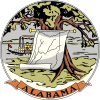| Alabama | |
|---|---|
| Nickname(s): "Yellowhammer State", "Heart of Dixie", "Cotton State" | |
 Map of the Confederate States | |
| Capital | Montgomery |
| Largest city | Mobile |
| Admitted to the Confederacy | March 13, 1861 (1st) |
| Population |
|
| Forces supplied | |
| Governor | Andrew B. Moore John Gill Shorter Thomas H. Watts |
| Senators | Clement Claiborne Clay Richard Wilde Walker William Lowndes Yancey Robert Jemison Jr. |
| Representatives | List |
| Restored to the Union | July 13, 1868 |
| History of Alabama |
|---|
|
|
 |
|
Confederate States in the American Civil War |
|---|
|
|
| Dual governments |
| Territory |
|
Allied tribes in Indian Territory |
Alabama was central to the Civil War, with the secession convention at Montgomery, the birthplace of the Confederacy, inviting other slaveholding states to form a southern republic, during January–March 1861, and to develop new state constitutions. The 1861 Alabaman constitution granted citizenship to current U.S. residents, but prohibited import duties (tariffs) on foreign goods, limited a standing military, and as a final issue, opposed emancipation by any nation, but urged protection of African-American slaves with trials by jury, and reserved the power to regulate or prohibit the African slave trade. The secession convention invited all slaveholding states to secede, but only 7 Cotton States of the Lower South formed the Confederacy with Alabama, while the majority of slave states were in the Union at the time of the founding of the Confederacy. Congress had voted to protect the institution of slavery by passing the Corwin Amendment on March 4, 1861, but it was never ratified.[3]
Even before secession, the governor of Alabama Andrew B. Moore defied the United States government by seizing the two federal forts at the Gulf Coast (forts Morgan and Gaines) and the arsenal at Mount Vernon in January 1861 to distribute weapons to Alabama towns. The peaceful seizure of Alabama forts preceded by three months the bombing and capture of the Union's Fort Sumter (SC) on April 12, 1861.
Alabama was politically divided, voting to secede 61–39%, with most opposition by Unionists in northern Alabama. Citizens would subsequently join Confederate forces, with some Alabamians joining Union forces. Issues of slavery also were divided, with emancipation denied, but slaves protected, allowed trial by jury same as free whites, and African Slave Trade was discouraged in the 1861 Ordinances.
Alabama provided a significant source of troops and leaders, military material, supplies, food, horses and mules. At the southern coast, the Alabama ports remained open (with Union blockades, but guarded by forts, floating mines, and obstacle paths) for almost 4 years using blockade runners, until the Battle of Mobile Bay (Aug 1864) and the Battle of Fort Blakeley (April 1865) forced Mobile to surrender the last major Confederate port.
- ^ "The Civil War in Alabama", Legends of America, Retrieved January 29, 2021
- ^ Lardas, Mark N. African American Union Troops | Encyclopedia of America. Retrieved January 29, 2021.
- ^ "Abraham Lincoln and the Corwin Amendment". Retrieved June 17, 2020.

